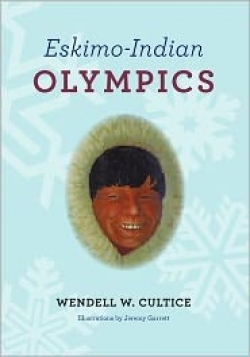Eskimo-Indian Olympics
Rhoda Nageak skinned a seal in 57 seconds. Homer Lord carried four grown men a distance of 187 feet without dropping them. And Michael Paulsen walked 2,886 feet 10 inches with 31 one-pound weights hung from his ear. Eskimo-Indian Olympics, written by Wendell Cultice and illustrated by Jeremy Garrett, describes these events and others that comprise the competition. The author also lists event record holders and provides a very brief history to ground the events contextually.
As principal of Austin E. Lathrop High School in Fairbanks, where the Eskimo Olympics originated in 1961, and president of the Alaska High School Activities Association for four years, author, historian, and educator Wendell Cultice has strong credentials for writing Eskimo-Indian Olympics.
Cultice notes that the contests are “tests of pain, endurance, and agility which have been handed down in [Eskimo] villages for centuries.” They test participants’ mettle, particularly as it relates to Arctic survival skills such as hunting and whaling.
As a nonfiction compendium of the events that constitute the Eskimo-Indian Olympics, Cultice’s book achieves its stated goal. To involve the reader, the author may have chosen to embed descriptions of the Olympics’ events within a fictional story of an Eskimo youth who overcomes obstacles in his desire to compete and win; the events could have come alive in stupendous fashion. That approach could have engaged readers more completely and, as a result, given them a better understanding of the connections between the events and participants’ ability to flourish in the Arctic, certainly among the harshest of environments on Earth.
Still, the author’s clear, sparse language makes content accessible even to younger readers. And Jeremy Garrett’s Inuit-style charcoal drawings clarify meaning where words alone do not suffice in creating an image. So, readers aged six to twelve years—boys, in particular—should find this text interesting.
But, caveat emptor: Kids being kids, youth may well attempt to recreate the events described in Eskimo-Indian Olympics. Certain contests—such as the excruciatingly painful ear pull competition and the belt wrestling event (which requires contestants bound in fetal position to “sit squarely on the other wrestler’s head”)—can result in serious physical trauma.
Adults who share this book with young readers would be well advised, therefore, to highlight and even expand upon the easy-to-miss admonition tacked to the end of the Table of Contents: “While the intent of this book is to be both entertaining and informative, it is not recommended that you attempt the events described.”
Reviewed by
Nancy Walker
Disclosure: This article is not an endorsement, but a review. The publisher of this book provided free copies of the book and paid a small fee to have their book reviewed by a professional reviewer. Foreword Reviews and Clarion Reviews make no guarantee that the publisher will receive a positive review. Foreword Magazine, Inc. is disclosing this in accordance with the Federal Trade Commission’s 16 CFR, Part 255.

